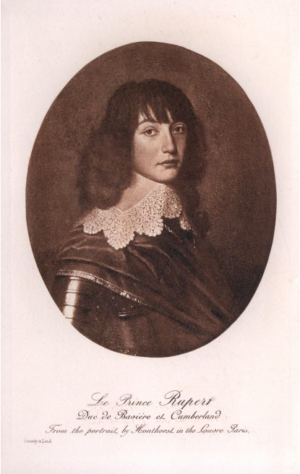As promised some time ago, here’s the story of an attempted IED attack in 1650.
In 1650 the second part of the English Civil War was taking place. A key Royalist commander and former cavalry chief was Prince Rupert. Prince Rupert is a very interesting gentleman, with a keen scientific interest in explosives and invention. With significant experience as a general in the 30 Years War in Europe, his dashing exploits as a cavalry commander in various battles, including Edgehill, and as an extremely ruthless Royalist leader gave him a bogeyman status amongst the Parliamentarians. By 1650 he was commanding a Royalist fleet of vessels, being pursued by a Parliamentarian fleet.

In 1650, his fleet took refuge in the River Tagus, near Lisbon in Portugal. The opposition fleet also lay at anchor not far off with the Portuguese enforcing some sort of ceasefire between the two fleets while they competed for support from the Portuguese king. Trade between the merchants of Lisbon and the two fleets was natural, and Prince Rupert tried to take advantage of this.
Prince Rupert designed a large improvised explosive device in a barrel, dressed a member of his crew as a merchant and employed two locals to row a small boat, amongst other trading dinghies, down towards HMS Leopard, the key enemy warship. They entered into a trade to sell the “barrel of oil” with the quartermaster of HMS Leopard, and after agreeing a price the barrel was being hoisted aboard when the Leopard’s crew became suspicious. The three man crew were seized and the barrel investigated. It was found that a large explosive filled shell had been placed inside the barrel. A string from the merchant’s boat led in through the bunghole, to a pistol. Pulling the string would fire the pistol and ignite quickfuze leading to the shell. It was clear that the plan was to initiate the device once it had been swing aboard, killing as many of the crew as possible and damaging the ship.
Ten years later, after the war was over Prince Rupert became one of the three founders of the Royal Society. The Royal Society took great interest in research into explosives and related inventions, and Prince Rupert himself published a paper at the Royal Society on an improved recipe for gunpowder in 1662.
Of course, students of modern day terrorism will see the instant parallels with the USS Cole attack in Yemen in October 2000, which again involved perpetrators approaching a warship with an IED, disguised as a local boat in a port. The investigation after the USS Cole attack noted the following failures:
- There was no co-ordinated effort to track the movement of small boats in the harbour;
- The Cole’s own small boat, which should have been used to investigate the approach of any suspicious craft, was not ready for launching.
It appears that HMS Leopard was pretty much the same, but luckier.

I very much enjoyed your Prince Rupert article. I am in the process of writing a book with Rupert as a main character and his time at Lisbon in 1650 is a part of that. He was, although it is debatable, an inventor before his time. Very well written, thank you. I enjoyed it~
Kelli